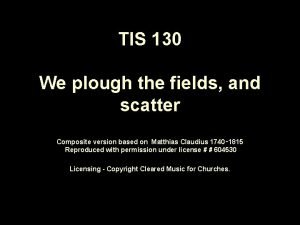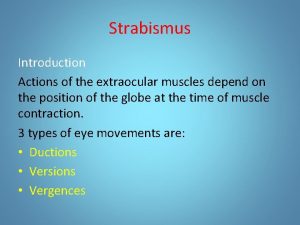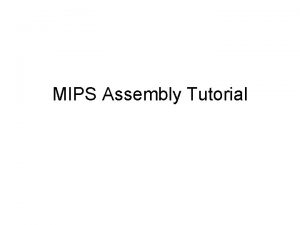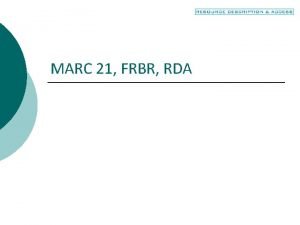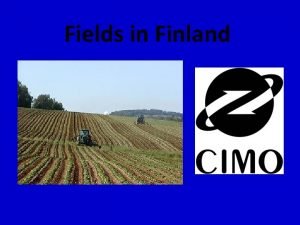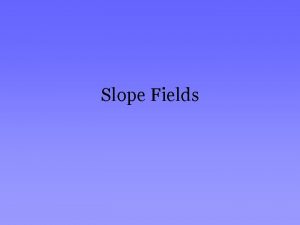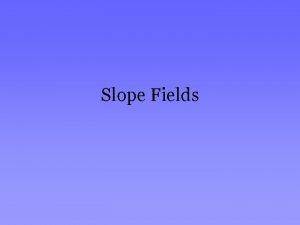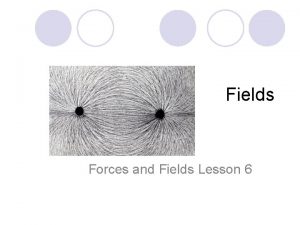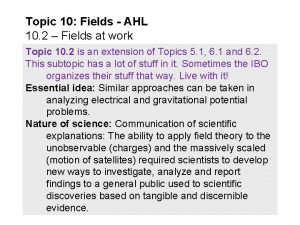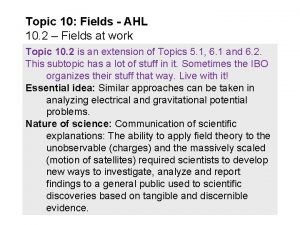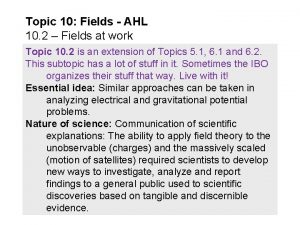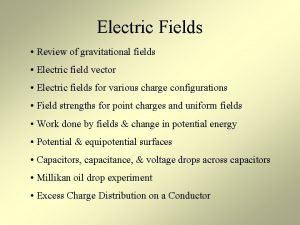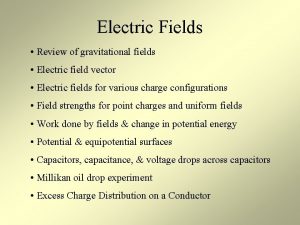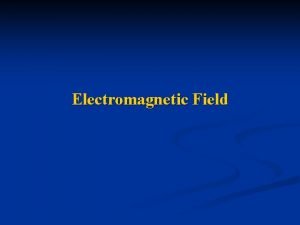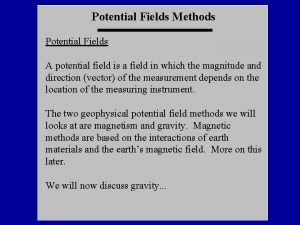Topic Fields Definition Field F A field is























- Slides: 23

Topic: Fields Definition: Field ( F, +, · ) A field is a set F with two operations ‘+’ and ‘·’. (1) For any a, b F , a + b F and a · b F (2) For the addition, ( F, +) is an Abelian group: a+b=b+a a + (b + c) = (a + b) + c 0 F s. t. a + 0 = a a F s. t. ( a) + a = 0 (2) For the multiplication, a·b=b·a a · (b · c) = (a · b) · c a · (b + c) = a · b + a · c 1 F s. t. a · 1 = a a 0 of F a 1 F s. t. a 1 · a = 1 (Closure) (Commutative) (Associative) (Zero element) (Negatives) (Commutative) (Associative) (Distributive) (Unit element) (Inverses) If a · b = b · a is omitted, the structure becomes a division ring. Historically, division rings were called fields, and fields were commutative fields.

Examples: R , Q and C are fields wrt the usual + & · operations, but I is not. Example: The set { 0, 1 } under the operations: is a field. All vector space theorems concernimg ( V, +; R ) can be applied to ( V, +; F ). Reminder: norms & inner products are not part of the vector space.

Exercises: Fields 1. Give suitable operations to make the set { 0, 1, 2 } a field.

Table salt comes in little cubes. Reason: Na. Cl atoms are arranged in a periodic structure called crystal. 2 interpenetrated Face-Centered-Cubic structures. Unit cell

T = Translation vector { a 1 , a 2 } = fundamental translation vectors Volume bounded by { a 1 , a 2 } = unit cell. Crytal Structure = Lattice + Basis Primitive unit cell = smallest unit cell. Unit cells are not unique.

Graphite Fundamental translation vectors (Also called basis vectors ): ABAB… Hexagonal Closed Packed ABCABC… F. C. C.

Diamond Fundamental translation vectors (basis vectors ) for the cubic unit cell:

Exercises: Crystals 1. Give the locations of the atoms in the diamond cube both in terms of the fundamental translation vectors, and in Angstroms. 2. This illustrates how the dimensions of a unit cell could be computed from the shape in which a substance crystalizes. (a) Recall that there are 6: 022 1023 atoms in a mole (this is Avagadro’s number). From that, and the fact that platinum has a mass of 195. 08 grams per mole, calculate the mass of each atom. (b) Platinum crystalizes in a face-centered cubic lattice with atoms at each lattice point, that is, it looks like the middle picture given above for the diamond crystal. Find the number of platinums per unit cell (hint: sum the fractions of platinums that are inside of a single cell). (c) From that, find the mass of a unit cell. (d) Platinum crystal has a density of 21. 45 grams per cubic centimeter. From this, and the mass of a unit cell, calculate the volume of a unit cell. (e) Find the length of each edge. (f) Describe a natural three-dimensional basis (fundamental translation vectors).

Topic: Voting Paradoxes Result of a mock election in Political Science class (> means ‘is preferred to’): Dem > Rep = 5+4+8 = 17 Rep > Dem = 2+8+2 = 12 Dem > Third = 5+4+2 = 11 Third >Dem = 8+8+2 = 18 Rep > Third = 5+2+8 = 15 What is the preference of the group as a whole? Voting paradox: Majority cycle. → Everyone can be the majority. Third > Rep = 4+8+2 = 14

A tendency toward cyclic preference is present in each voter’s preference list. It surfaces in the total when there is more adding of the tendency than cancelling. A voter with the preference D > R > T contributes to the cycle Mock election: Vector representation: Mock election:

Cyclic subspace: Acyclic subspace: Basis for R 3 = C C or

E. g. , for a D > R > T voter: → T > R > D (Opposite) voter: →

Opposite spins cancel. Voting paradox happens when resultant vector is cyclic ( all components are of the same sign ).

Exercises: Voting Paradox A one-voter election cannot have a majority cycle because of the requirement that we’ve imposed that the voter’s list must be rational. (a) Show that a two-voter election may have a majority cycle. (We consider the group preference a majority cycle if all three group totals are nonnegative or if all three are nonpositive—that is, we allow some zero’s in the group preference. ) (b) Show that for any number of voters greater than one, there is an election involving that many voters that results in a majority cycle. Kenneth J. Arrow shared the 1972 Nobel prize for economics in part for showing, essentially, that no voting system is entirely fair.

Topic: Dimensional Analysis Definition: Dimensional Constant A physical quantity whose numerical value depends on the units chosen for fundamental quantities but not on the system being considered. ISQ Symbol for dimension SI base unit Base Quantities Symbol for quantity Length l L meter Time t T second Mass m M kilogram Electric current I I ampere Thermodynamic temperature T θ kelvin Amount of substance n N mole Luminous intensity Iv J candela

Ref: P. W. Bridgman, Dimensional Analysis, Yale University Press, 1931. Dimensional analysis: All equations must be dimensionally homogenous. Example: Period of pendulum length of pendulum [ l ] = L & gravitational acceleration [ g ] = L T 2 →

Buckingham’s Theorem: Any dimensional formulas can be written as where { Π 1 , … , Πn } is a complete set of dimensionless products. → Example: Period of pendulum Dimensionless product term:

→ → Complete set: Buckingham’s Theorem: →

Kepler’s Problem →

→ Complete set: Buckingham’s Theorem: Kepler’s Third Law

Wave in Deep Water Lord Raleigh →

→ Complete set: Buckingham’s Theorem:

Exercises: Dimension Analysis Einstein conjectured that the infrared characteristic frequencies of a solid may be determined by the same forces between atoms as determine the solid’s ordinary elastic behavior. The relevant quantities are Show that there is one dimensionless product. Conclude that, in any complete relationship among quantities with these dimensional formulas, k is a constant times ν 2 N 1/ 3 m 1. This conclusion played an important role in the early study of quantum phenomena.
 Red fields
Red fields Example of a clincher
Example of a clincher Broad and specific topic examples
Broad and specific topic examples Gauss law of magnetism
Gauss law of magnetism Individual differences factors
Individual differences factors Field dependent vs field independent
Field dependent vs field independent Q factor of capacitor
Q factor of capacitor Waveguide cutoff frequency
Waveguide cutoff frequency Data types and field properties
Data types and field properties Field dependent definition
Field dependent definition Difference between electric field and magnetic field
Difference between electric field and magnetic field Norm rule fields
Norm rule fields How many fields in computer science
How many fields in computer science Electric forces and fields concept review
Electric forces and fields concept review We plough the fields and scatter modern version
We plough the fields and scatter modern version Suprasternal notch
Suprasternal notch Hirschburg test
Hirschburg test 6 cardinal fields of gaze
6 cardinal fields of gaze Medusa poem analysis
Medusa poem analysis Slope fields ap calculus
Slope fields ap calculus Rodan and fields tax write offs
Rodan and fields tax write offs Spim tutorial
Spim tutorial Frbr entities
Frbr entities Learning: module 26: magnetic forces and fields
Learning: module 26: magnetic forces and fields














